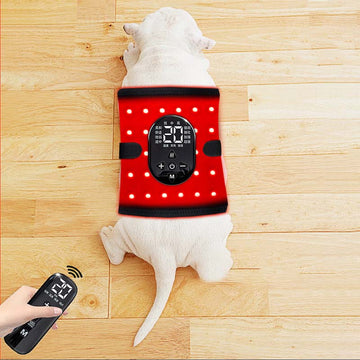What is Red LED Therapy?
Red LED therapy is a therapeutic technique that exposes your body to low-wavelength red light, typically between 630-850 nanometers (nm). This specific range of light penetrates your skin at varying depths to stimulate cellular energy production and promote various healing processes.
Key Characteristics of Red LED Therapy:
Wavelengths Used:
- Red Light (630-700 nm): Penetrates 8-10 mm into the skin, ideal for surface-level benefits like skin rejuvenation
- Near-Infrared Light (700-850 nm): Penetrates deeper (up to 50 mm), reaching muscles, joints, and bones
Treatment Properties:
- Non-invasive and painless
- No downtime required
- No heat generation (unlike laser treatments)
- Safe for daily use when used correctly
The term "LED" stands for Light Emitting Diode, which is the technology used to produce these specific wavelengths efficiently and safely for therapeutic purposes.
The History of Red LED Therapy
The journey of red LED therapy is fascinating and spans several decades of scientific discovery.
Early Discoveries (1960s-1990s)
The foundation for red LED therapy began in 1967 when Hungarian physician Dr. Endre Mester discovered that low-level laser light could stimulate hair growth and wound healing in mice. This accidental discovery marked the birth of photobiomodulation—the scientific term for how light affects biological tissue.
NASA's Contribution (1990s)
Red LED therapy gained significant credibility in the 1990s when NASA began researching LED technology for plant growth experiments in space. Scientists discovered that red and near-infrared LEDs not only helped plants grow but also accelerated wound healing in astronauts and promoted tissue regeneration.
NASA's research proved that LED-based therapy was:
- More cost-effective than laser treatments
- Safer for prolonged exposure
- Effective for medical applications
Modern Era (2000s-Present)
Today, red LED therapy has evolved from experimental treatment to mainstream wellness solution. Thousands of clinical studies have validated its effectiveness for various conditions, and the technology has become accessible for both professional and home use.
The FDA began clearing red LED therapy devices for specific uses, including pain management and skin treatment, further legitimizing this therapeutic approach.
How Does Red LED Therapy Work? The Science Explained
Understanding how red LED therapy works requires a look into cellular biology. Don't worry—we'll keep it simple!
Cellular Energy Production
At the heart of red LED therapy's effectiveness is its impact on your cells' powerhouses: mitochondria.
The Process:
- Light Absorption: When red LED light reaches your cells, it's absorbed by chromophores (light-sensitive molecules) within the mitochondria, particularly cytochrome c oxidase.
- ATP Production: This light absorption stimulates the production of adenosine triphosphate (ATP)—the energy currency your cells use to function, repair, and regenerate.
-
Increased Cellular Activity: With more ATP available, your cells can perform their functions more efficiently, including:
- Tissue repair and regeneration
- Collagen production
- Inflammation reduction
- Improved blood circulation
Nitric Oxide Release
Red LED therapy also promotes the release of nitric oxide, a molecule that:
- Improves blood flow
- Reduces inflammation
- Enhances oxygen delivery to tissues
- Supports cardiovascular health
Reduced Oxidative Stress
The therapy helps neutralize harmful free radicals and reduces oxidative stress, which contributes to:
- Slower aging processes
- Better cellular health
- Reduced inflammation
- Enhanced recovery
Think of red LED therapy as "charging" your cellular batteries, giving your body the energy boost it needs to heal and function optimally.
Red LED Therapy vs. Other Light Therapies
It's easy to confuse red LED therapy with other light-based treatments. Let's clear up the differences:
Red LED Therapy vs. Blue Light Therapy
| Feature | Red LED Therapy | Blue Light Therapy |
|---|---|---|
| Wavelength | 630-850 nm | 400-495 nm |
| Penetration Depth | Deep (up to 50 mm) | Shallow (1-2 mm) |
| Primary Uses | Anti-aging, pain relief, muscle recovery | Acne treatment, mood disorders |
| Mechanism | Increases ATP production | Kills acne-causing bacteria |
Red LED Therapy vs. Laser Therapy
While both use light for therapeutic purposes, there are important distinctions:
Red LED Therapy:
- Uses multiple wavelengths simultaneously
- Covers larger treatment areas
- No risk of tissue damage
- More affordable
- Suitable for home use
Laser Therapy:
- Uses single, concentrated wavelength
- More intense and focused
- Requires professional supervision
- Higher cost
- Used for specific medical procedures
Red LED Therapy vs. UV Light
This is crucial: Red LED therapy is completely different from UV light exposure.
- UV Light: Can damage DNA, cause sunburn, increase skin cancer risk
- Red LED Therapy: Non-damaging, therapeutic, promotes healing
Red LED therapy does not emit harmful UV radiation and is considered safe for regular use.
What Does the Science Say? Research-Backed Evidence
Red LED therapy isn't just wellness hype—it's backed by substantial scientific research.
Clinical Research Highlights
Skin Health Studies: A 2014 study published in Photomedicine and Laser Surgery found that participants using red LED therapy showed significant improvements in skin complexion, collagen density, and reduction in fine lines after 30 sessions.
Pain Management Research: Multiple studies have demonstrated red LED therapy's effectiveness for chronic pain conditions. A 2015 systematic review in The Lancet analyzed 22 trials and concluded that photobiomodulation significantly reduces pain in various musculoskeletal conditions.
Wound Healing Evidence: Research published in Wound Repair and Regeneration showed that red LED therapy accelerated healing in chronic wounds by 40-60% compared to standard care alone.
Athletic Performance: A 2016 study in Lasers in Medical Science found that athletes using red LED therapy before workouts experienced reduced muscle fatigue and faster recovery times.
Growing Medical Acceptance
Over 4,000 peer-reviewed studies have been published on photobiomodulation, with research continuing to expand into new therapeutic applications. Major medical institutions, including Harvard Medical School and Mayo Clinic, have acknowledged the therapeutic potential of red LED therapy.
Is Red LED Therapy Safe?
One of the most appealing aspects of red LED therapy is its excellent safety profile.
Safety Considerations
General Safety:
- Non-ionizing radiation (unlike X-rays)
- No thermal damage to tissue
- No known serious side effects when used properly
- Suitable for most skin types and ages
Potential Mild Side Effects:
- Temporary eye strain (wear protective eyewear)
- Mild headache (rare, usually from excessive exposure)
- Slight skin redness (temporary, subsides quickly)
Who Should Use Caution
While red LED therapy is generally safe, certain individuals should consult healthcare providers first:
- Pregnant or nursing women
- People taking photosensitizing medications
- Individuals with active cancer or cancer history
- Those with epilepsy (flashing lights may trigger seizures)
- People with thyroid conditions (avoid direct neck exposure)
Best Practices for Safe Use
- Follow manufacturer guidelines for distance and duration
- Wear protective eyewear if recommended
- Start with shorter sessions (5-10 minutes) and gradually increase
- Maintain consistent routine rather than excessive single sessions
- Consult professionals for specific health conditions
Frequently Asked Questions About Red LED Therapy
How long does it take to see results from red LED therapy?
Results vary depending on the condition being treated and individual factors. Generally:
- Skin improvements: 4-6 weeks with regular use
- Pain relief: Some notice improvements within days; significant results in 2-4 weeks
- Muscle recovery: Often felt within 24-48 hours post-treatment
- Wound healing: Progressive improvement over several weeks
Consistency is key—most benefits accumulate with regular use over time.
How often should I use red LED therapy?
For optimal results, most experts recommend:
- Initial phase: 3-5 times per week for 4-6 weeks
- Maintenance phase: 2-3 times per week ongoing
- Session duration: 10-20 minutes per treatment area
Individual needs may vary based on specific goals and device specifications.
Can I use red LED therapy every day?
Yes, red LED therapy is generally safe for daily use. However, more isn't always better. Your cells need time to utilize the increased ATP production, so consistent moderate use typically produces better results than excessive exposure.
Does red LED therapy really work?
Yes, when used correctly. Thousands of clinical studies support its effectiveness for various applications, including skin health, pain management, and tissue repair. However, realistic expectations are important—red LED therapy is a supportive treatment that enhances your body's natural healing, not a miracle cure.
What's the difference between red and near-infrared light?
Both are forms of red LED therapy, but they penetrate differently:
- Red light (visible): Works primarily on surface-level skin concerns
- Near-infrared (invisible): Penetrates deeper to reach muscles, joints, and organs
Many devices combine both wavelengths for comprehensive benefits.
Is red LED therapy the same as tanning beds?
Absolutely not. Tanning beds emit harmful UV radiation that damages skin and increases cancer risk. Red LED therapy uses beneficial wavelengths that promote healing without any UV exposure. They are completely different technologies with opposite effects on skin health.
Conclusion: Is Red LED Therapy Right for You?
Red LED therapy represents a fascinating intersection of ancient light healing wisdom and modern scientific understanding. This non-invasive, safe, and increasingly accessible treatment offers a drug-free approach to supporting your body's natural healing processes.
Key Takeaways:
✅ Red LED therapy uses specific light wavelengths to boost cellular energy production
✅ Backed by thousands of scientific studies and NASA research
✅ Safe for most people when used correctly
✅ Effective for skin health, pain relief, recovery, and more
✅ Available in both professional and home-use devices
Whether you're interested in improving your skin, managing chronic pain, enhancing athletic recovery, or simply optimizing your overall wellness, red LED therapy offers a scientifically-validated option worth considering.
As with any health treatment, we recommend consulting with healthcare professionals, especially if you have specific medical conditions. Start with realistic expectations, remain consistent with your treatment schedule, and give your body time to respond to this innovative therapy.
Ready to explore the specific benefits of red LED therapy? Check out our next article: "10 Science-Backed Benefits of Red Light Therapy" to discover exactly how this treatment can support your health goals.
References:
- Wunsch, A., & Matuschka, K. (2014). A controlled trial to determine the efficacy of red and near-infrared light treatment in patient satisfaction, reduction of fine lines, wrinkles, skin roughness, and intradermal collagen density increase. Photomedicine and Laser Surgery, 32(2), 93-100.
- Bjordal, J. M., et al. (2003). A systematic review of low level laser therapy with location-specific doses for pain from chronic joint disorders. The Lancet, 361(9357), 557-558.
- NASA (1999). Light-Emitting Diode Technology for Pain Management. Marshall Space Flight Center Research Reports.





